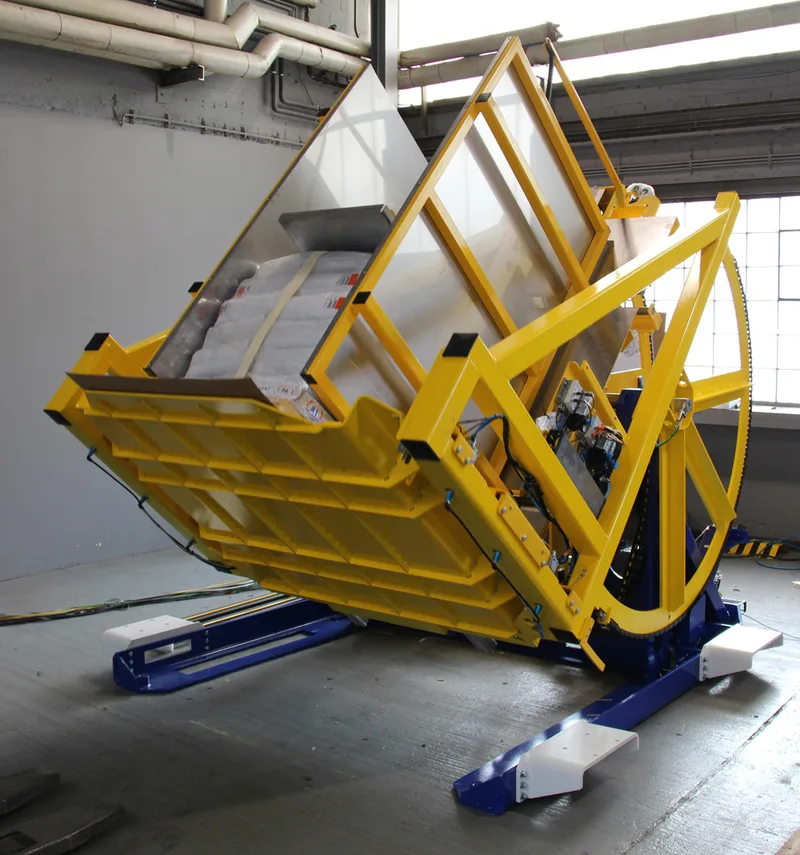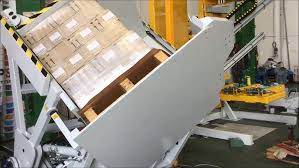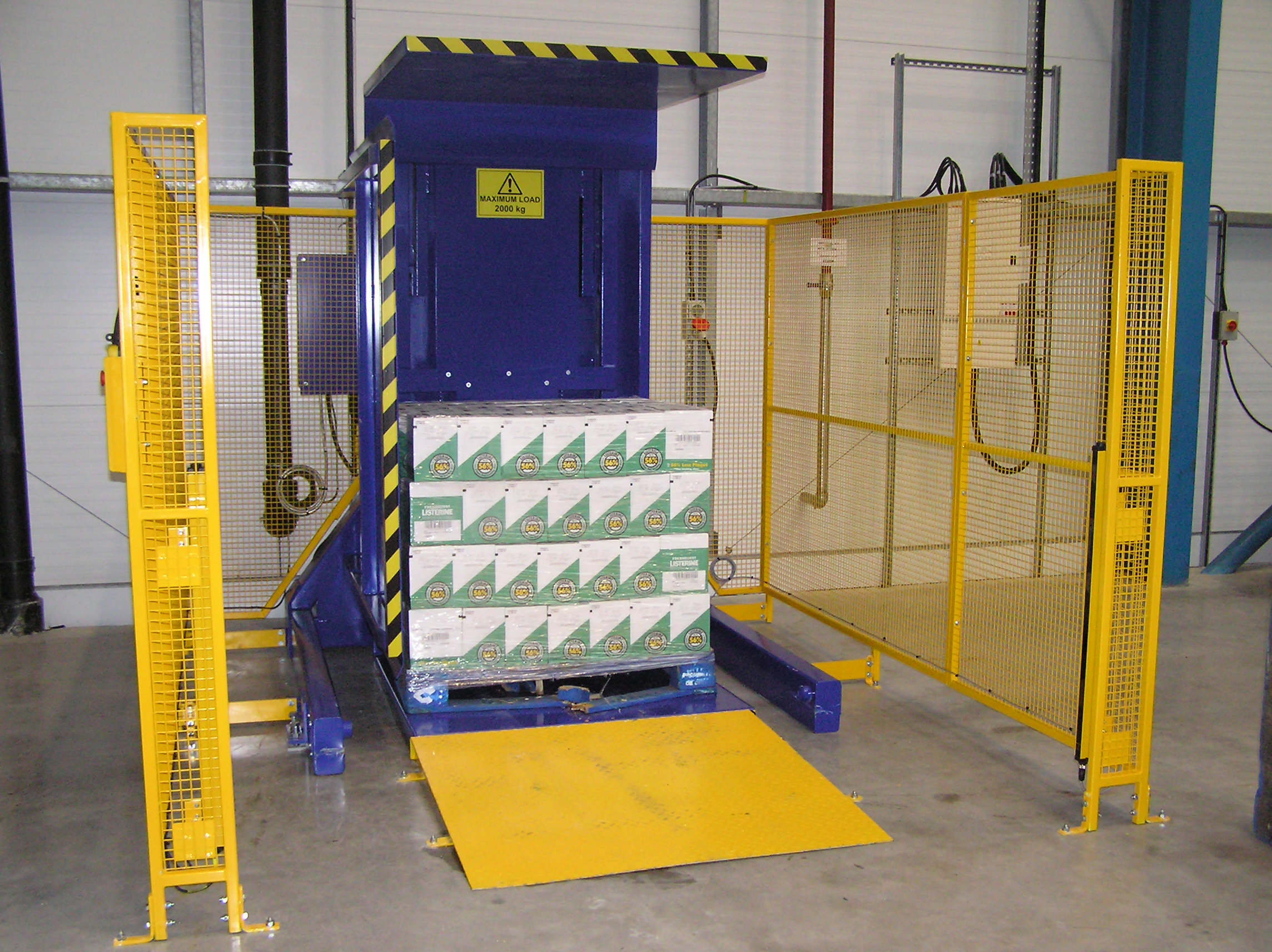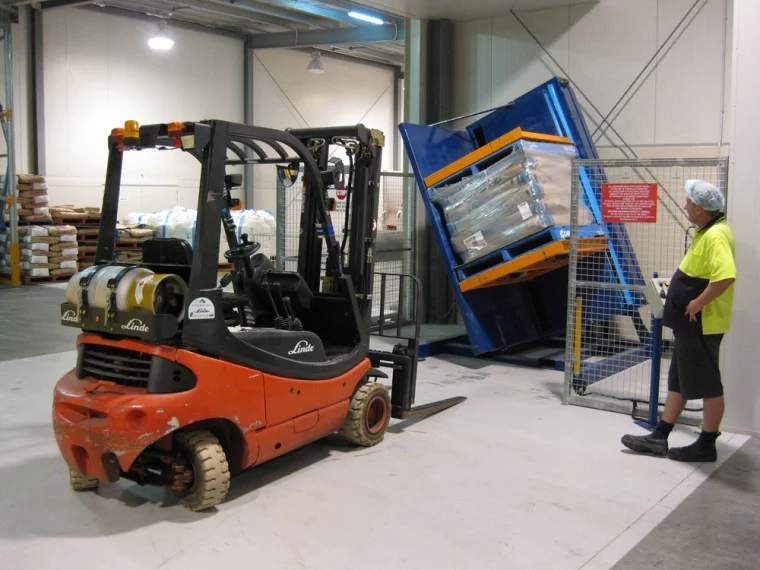Why Are United States's Manufacturers Replacing Manual Handling with Pallet Inverters?
Manual handling of heavy pallet loads is a constant struggle in many factories across the United States. It's slow. It's dangerous. It costs a lot of money. I've seen firsthand how back injuries, damaged goods, and production delays create headaches for plant managers. Imagine the daily grind of dealing with workers' compensation claims. Or the frustration of product returns because items were damaged during transfer. These are not small problems. They directly impact your profits and your reputation. What if there was a straightforward mechanical solution that could address these issues? Many US manufacturers are now realizing that the pallet inverter is that answer.
Manufacturers in the United States are replacing manual handling with pallet inverters to significantly improve workplace safety, lower labor costs, boost operational efficiency, and protect product quality. This single piece of equipment automates the task of rotating a full pallet load, removing the need for risky and time-consuming manual restacking.

This might sound like a big claim for one machine. But I want to show you exactly how a pallet inverter can transform your factory floor. It's more than just a piece of equipment; it's a strategic investment in a safer, more profitable operation. My journey from a factory engineer to a factory owner has taught me to look for solutions that provide clear, measurable value. Let’s break down the specific benefits.
How Can Pallet Inverters Enhance Workplace Safety in US Factories?
Every year, I hear stories from colleagues in the United States about workplace injuries. Many of these incidents involve heavy lifting and manual handling. These musculoskeletal injuries are painful for the employee. They are also incredibly expensive for the company. Think about the costs. There are direct medical bills and rising insurance premiums. There are also indirect costs like lost productivity and the challenge of replacing a skilled worker. This is a constant risk that hangs over any operation that relies on manual labor for heavy tasks. But there is a way to engineer this risk out of your process. A pallet inverter offers a powerful solution by mechanizing the most dangerous lifting tasks.
Pallet inverters enhance workplace safety by completely eliminating the need for employees to manually unstack and restack goods. The machine securely clamps and rotates the entire palletized load. This allows a single worker to swap pallets or access items on the bottom layer without any physical strain, which dramatically reduces the risk of back injuries and other common manual handling accidents.

I believe in looking at problems from an engineer's perspective. When we talk about safety, we often look for ways to control hazards. A pallet inverter is a perfect example of a high-level engineering control. It doesn't just warn people about a danger; it removes the dangerous task itself. This is the most effective way to create a safer workplace.
A Deeper Look at Manual Handling Risks
Manual handling is one of the leading causes of non-fatal injuries in the American manufacturing sector. The Occupational Safety and Health Administration (OSHA) has extensive guidelines on ergonomics for a reason. The physical toll is significant. Repetitive lifting, bending, and twisting under load can lead to chronic conditions. These include lumbar strains, herniated discs, and shoulder injuries. These are not minor issues. They can lead to long-term disability for an employee and significant financial liability for an employer. The cost of a single serious injury can easily exceed the cost of a machine designed to prevent it.
Let's compare the two processes directly:
| Safety Factor | Manual Pallet Exchange | Using a Pallet Inverter |
|---|---|---|
| Lifting Requirement | Employee lifts every box or bag. | Zero manual lifting of product. |
| Risk of Strain/Sprain | Very High | Negligible |
| Ergonomic Stress | High (bending, twisting, reaching) | Low (pushing buttons) |
| Risk of Dropped Product | Moderate to High | Very Low |
| Required Personnel | Often 2 or more people | 1 operator |
My Insight: The True Value of an Engineering Control
I once visited a client's large distribution center in Ohio. They had a 'safety champion' award every month to encourage safe practices. It was a good idea, but they were still seeing injuries in their pallet handling area. I talked to the plant owner, a man very focused on numbers and results. He was skeptical about new equipment. I explained that a pallet inverter isn't just a machine; it's a permanent safety solution. We installed one at his main receiving dock to switch incoming goods from low-quality pallets to their internal high-grade ones.
Six months later, he called me. He told me their injury reports for that section of the warehouse had dropped to zero. Not just down, but to zero. The machine had already paid for itself in reduced insurance premiums and the elimination of lost work time. He said his safety manager called it the best investment the company had ever made. This is what I mean by giving back. Sharing this knowledge helps other business owners like him protect their people and strengthen their company. It transforms safety from an expense into an investment with a clear return.
What Are the Direct Economic Benefits of Using Pallet Inverters in Manufacturing?
Labor costs in the United States are always a major factor in business decisions. Finding good, reliable workers for physically demanding jobs is also becoming more difficult. I've seen many companies struggle with this. Manual pallet handling is a perfect example of a slow, labor-intensive process that directly inflates your operational costs. Every minute your team spends manually unstacking a pallet, moving the goods, and restacking them is a minute they are not doing something more valuable. If you calculate that lost time over a full year, the number is often shocking. You are essentially paying for inefficiency. A pallet inverter changes this equation completely. It can turn a task that takes two people 20-30 minutes into a job that one person can do in about 2 minutes. The economic impact is immediate and very easy to measure.
The most direct economic benefits of using pallet inverters are significant reductions in labor costs, lower expenses from product damage during handling, and the potential for reduced workers' compensation insurance premiums. The speed of the machine also increases throughput, allowing more product to be processed and shipped using the same number of staff, which directly boosts revenue potential.

When I started my own factory, every dollar counted. I learned to analyze every investment not by its price tag, but by its potential return. A pallet inverter is a classic case where the return on investment (ROI) is fast and clear. It’s not just about spending money on equipment; it’s about investing in a more profitable process.
Calculating the Return on Investment (ROI)
For a practical business owner, the numbers have to make sense. Let's look at how you can calculate the ROI for a pallet inverter. It's a simple exercise, but a powerful one. You can break down the savings into a few key areas.
Here is a basic framework:
| Cost Saving Area | Calculation Example | Your Estimated Annual Savings |
|---|---|---|
| Labor Savings | (25 min saved per pallet) x (20 pallets/day) x ($20/hr labor cost) x (250 days/year) | ~$70,000 |
| Product Damage Reduction | ($500/month in damaged goods) x (12 months) | ~$6,000 |
| Insurance Savings | (Potential 5% reduction on premium) | Varies |
| Total Estimated Savings | ~$76,000+ |
These numbers are examples. You should use your own data for an accurate calculation.
My Insight: Unlocking Hidden Potential
I was working with a steel coil processor in Mexico. The owner, Javier, was a sharp, forward-thinking leader but also very cautious with capital spending. He saw the purchase price of a pallet inverter and was hesitant. He understood the safety benefits, but he needed a stronger financial case. We sat down and ran the numbers together, just like in the table above. The labor savings were clear.
But then we looked deeper. He had two workers who spent most of their day restacking coils that came in on broken pallets. This was a bottleneck that held up his entire receiving department. I asked him, "If those two workers were not restacking coils, what could they be doing?" He thought for a moment and realized they could be trained to operate a new slitting line he wanted to run a second shift on. We installed the pallet inverter. The two workers were retrained. Within three months, his plant's total output increased by 15% because that second shift was now running. The pallet inverter didn't just save him money on labor. It unlocked new capacity and generated new revenue. That is the power of looking at equipment as a strategic tool, not just a cost. It solves one problem and creates new opportunities.
How Do Pallet Inverters Contribute to Operational Efficiency and Throughput?
In any factory, flow is everything. A smooth, continuous flow of materials means a healthy, efficient operation. Production lines stop for many reasons, but one of the most frustrating is a simple bottleneck in the packaging or shipping area. Imagine a truck arriving with raw materials, but the pallets are damaged and cannot be put into your automated warehouse. Everything stops until that load is manually restacked. Or imagine a finished product ready for shipping, but it needs to be transferred to a different type of pallet for the customer. Another delay. These small stops have a domino effect. They delay shipments, frustrate customers, and throw your whole production schedule off balance. These little delays add up to huge losses in efficiency. Pallet inverters are designed to eliminate exactly these kinds of bottlenecks. They create a smooth, predictable, and fast flow of goods from production to warehouse to truck.
Pallet inverters contribute to operational efficiency by drastically cutting down the time required to transfer loads between pallets. A process that could take up to 30 minutes manually is safely completed in under two minutes with a machine. This speed eliminates critical bottlenecks, keeps production lines and loading docks moving, and increases the overall throughput of the entire facility.

I am passionate about building efficient systems. That's what we do at SHJLPACK. An efficient system minimizes waste. Wasted time is one of the biggest forms of waste in manufacturing. A pallet inverter is a targeted weapon against wasted time. By speeding up a single, crucial step, it improves the performance of the entire supply chain.
The Anatomy of a Process Bottleneck
A bottleneck is any point in a process where the flow is restricted, causing a backup. In manufacturing, pallet handling is a very common bottleneck. Here are a few examples where a pallet inverter breaks the jam:
- Receiving: A supplier sends you goods on a cheap, one-way pallet. Your internal system, perhaps an Automated Storage and Retrieval System (AS/RS), requires high-quality, standardized pallets. Manually restacking is a huge delay right at the start of your process. An inverter swaps the pallet in two minutes, and the goods flow into your system without interruption.
- Production: Sometimes a product needs to be flipped over for the next step in assembly or inspection. Doing this by hand is slow and risks damage. An inverter does it quickly and safely.
- *Cold Storage:** Many food producers need to transfer goods from standard wood pallets to plastic pallets before entering a freezer. Wood can absorb moisture and harbor bacteria. An inverter makes this transfer fast and hygienic.
Let's look at the time difference. This is where you see the impact on throughput.
| Task | Manual Transfer Time | Pallet Inverter Time | Efficiency Gain |
|---|---|---|---|
| Swap Broken Pallet | 20-30 minutes | ~2 minutes | >90% |
| Transfer to Plastic Pallet | 20-30 minutes | ~2 minutes | >90% |
| Invert Load for Access | 20-30 minutes | ~2 minutes | >90% |
My Insight: Linking Equipment to Broader Goals
I often talk to clients like Javier who have big goals, like increasing overall equipment effectiveness (OEE) or achieving 95% uptime. They are focused on the performance of their main production lines—the presses, the mills, the furnaces. They sometimes overlook how supporting processes can impact those big goals.
I was at a large beverage bottling plant in Texas. Their main goal was to increase the number of trucks they could load per day. Their bottling lines were running at peak capacity, but trucks were still waiting. The bottleneck was at the loading dock. They had to transfer finished pallets of drinks onto specialized shipping pallets for a major retail customer. This manual process was slow and holding everything up. We installed a pallet inverter right at the dock door. They were able to load trucks 30% faster. This didn't change the speed of the bottling line, but it dramatically increased the plant's total throughput. It helped them achieve their primary business goal. This shows that sometimes the best way to improve your main process is to fix the smaller processes that support it.
What Role Do Pallet Inverters Play in Quality Control and Product Integrity?
You have invested time, money, and expertise into making a perfect product. It passes all of your internal quality checks. Then, in the final handling stage before it ships to the customer, it gets damaged. A box is crushed during a manual transfer. A bag is torn on a broken pallet. A sensitive electronic component is jolted when a stack is dropped. This is incredibly frustrating. This damage represents more than just a loss of product. It is a direct hit to your company's reputation. When a customer receives a damaged shipment, they don't just see a broken box. They question your entire quality process. A pallet inverter helps protect your product at this final, critical stage. It handles your goods with a firm, gentle, and controlled motion, preserving their integrity and ensuring they reach your customer in perfect condition.
Pallet inverters play a vital role in quality control by minimizing product damage during handling. The machine's secure clamping system prevents loads from shifting or falling, while its smooth, controlled rotation protects sensitive goods. It also enables the easy and quick replacement of damaged or contaminated pallets, which helps maintain hygiene and overall product integrity.

As an engineer, I see a product's journey from raw material to finished good as one continuous process. Quality must be maintained at every single step. The final handling and packaging are just as important as the initial manufacturing. Protecting the product at this stage is essential, and a pallet inverter is a key tool for doing so.
Preventing Contamination and Physical Damage
Different industries face different quality risks. A pallet inverter is a versatile tool that can address many of them.
- Food, Beverage, and Pharmaceuticals: In these industries, hygiene is critical. Wood pallets can be a source of contamination. They can harbor mold, bacteria, and pests, or leave behind splinters. Government regulations and customer standards often require products to be on clean, sanitized plastic pallets. A pallet inverter allows for a quick, hands-free transfer from a wood "shipping" pallet to a hygienic "production" pallet without risking contamination of the product.
- Electronics and Fragile Goods: For sensitive electronics, a sudden jolt or drop can damage internal components without any visible external damage. Manual handling is inherently unpredictable. A pallet inverter provides a smooth, controlled motion. The clamping pressure is adjustable to hold the load securely without crushing it, protecting the value and function of the product inside.
- Bagged or Boxed Goods: Stacked boxes or bags are prone to shifting and tumbling during a manual transfer. This can lead to crushed corners, torn bags, and a messy, unsellable pallet. The inverter clamps the load from top and bottom, treating it as a single solid block. It rotates the block smoothly, ensuring the stack pattern remains perfect.
My Insight: Using Inversion for Better Inspection
Quality control is not just about preventing damage; it's also about finding it. A pallet inverter can become an active part of your QC process. I had a client who manufactures bags of industrial powder. They had a recurring problem where bags on the bottom layer of the pallet would get small tears from broken wood slats or protruding nails. They would only discover the problem when a customer complained about a leaking pallet. This was hurting their business.
We discussed their process. It was impossible to inspect the bottom of a fully loaded, shrink-wrapped pallet. The solution was simple but effective. We installed a pallet inverter at the end of their packaging line. Before shipping, each pallet was inverted 180 degrees. This gave a QC inspector clear, easy access to the entire bottom layer and the pallet itself. If they saw a torn bag or a broken pallet, they could fix the problem right there in a matter of minutes. Customer complaints about leaking bags dropped by over 90% in the first three months. It was a simple change in their process, enabled by one machine, that solved a major quality and customer satisfaction problem. It shows how the right equipment can give you more control over the quality of the product that leaves your factory.
Conclusion
Replacing manual handling with pallet inverters is a strategic move for US manufacturers, boosting safety, efficiency, and quality while delivering a strong, measurable return on investment.




